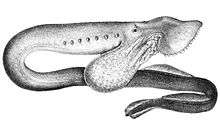Lamprey
Lampreys (sometimes inaccurately called lamprey eels) are an ancient extant lineage of jawless fish of the order Petromyzontiformes, placed in the superclass Cyclostomata. The adult lamprey may be characterized by a toothed, funnel-like sucking mouth. The common name "lamprey" is probably derived from Latin lampetra, which may mean "stone licker" (lambere "to lick" + petra "stone"), though the etymology is uncertain.[3] The plural form lamprey is sometimes seen.[4]
| Lamprey | |
|---|---|
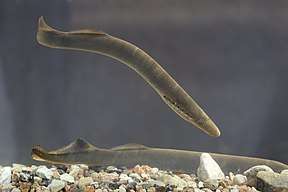 | |
| A European river lamprey (Lampetra fluviatilis) | |
| Scientific classification | |
| Kingdom: | Animalia |
| Phylum: | Chordata |
| Class: | Hyperoartia |
| Order: | Petromyzontiformes Berg, 1940[2] |
| Type species | |
| Petromyzon marinus | |
| Subgroups | |
† = extinct | |
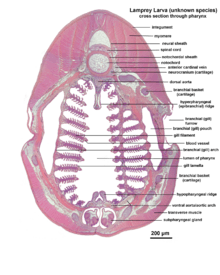
There are about 38 known extant species of lampreys and five known extinct species.[5] Parasitic carnivorous species are the most well-known, and feed by boring into the flesh of other fish to suck their blood;[6] but only 18 species of lampreys engage in this micropredatory lifestyle.[7][8] Of the 18 carnivorous species, nine migrate from saltwater to freshwater to breed (some of them also have freshwater populations), and nine live exclusively in freshwater. All non-carnivorous forms are freshwater species.[9] Adults of the non-carnivorous species do not feed; they live off reserves acquired as ammocoetes (larvae), which they obtain through filter feeding.
Distribution

Lampreys live mostly in coastal and fresh waters and are found in most temperate regions except those in Africa. Some species (e.g. Geotria australis, Petromyzon marinus, and Entosphenus tridentatus) travel significant distances in the open ocean,[10] as evidenced by their lack of reproductive isolation between populations. Other species are found in land-locked lakes. Their larvae (ammocoetes) have a low tolerance for high water temperatures, which may explain why they are not distributed in the tropics.
Lamprey distribution may be adversely affected by overfishing and pollution. In Britain, at the time of the Conquest, lampreys were found as far upstream in the River Thames as Petersham . The reduction of pollution in the Thames and River Wear has led to recent sightings in London and Chester-le-Street.[11][12]
Distribution of lampreys may also be adversely affected by dams and other construction projects due to disruption of migration routes and obstruction of access to spawning grounds. Conversely, the construction of artificial channels has exposed new habitats for colonisation, notably in North America where sea lampreys have become a significant introduced pest in the Great Lakes. Active control programs to control lampreys are undergoing modifications due to concerns of drinking water quality in some areas.[13]
Biology
 Basic external anatomy of a lamprey
Basic external anatomy of a lamprey
Adults superficially resemble eels in that they have scaleless, elongated bodies, and can range from 13 to 100 cm (5 to 40 inches) in length. Lacking paired fins, adult lampreys have large eyes, one nostril on the top of the head, and seven gill pores on each side of the head.
The pharynx is subdivided; the ventral part forming a respiratory tube that is isolated from the mouth by a valve called the velum. This is an adaptation to how the adults feed, by preventing the prey's body fluids from escaping through the gills or interfering with gas exchange, which takes place by pumping water in and out of the gill pouches instead of taking it in through the mouth.
Near the gills are the eyes, which are poorly developed and buried under skin in the larvae. The eyes consummate their development during metamorphosis, and are covered by a thin and transparent layer of skin that becomes opaque in preservatives.[14]
The unique morphological characteristics of lampreys, such as their cartilaginous skeleton, suggest they are the sister taxon (see cladistics) of all living jawed vertebrates (gnathostomes), and are usually considered the most basal group of the Vertebrata. Instead of true vertebrae, they have a series of cartilaginous structures called arcualia arranged above the notochord. Hagfish, which resemble lampreys, have traditionally been considered the sister taxon of the true vertebrates (lampreys and gnathostomes)[15] but DNA evidence suggests that they are in fact the sister taxon of lampreys.[16]
Studies have shown that lampreys are amongst the most energy-efficient swimmers. Their swimming movements generate low-pressure zones around their body, which pull rather than push their bodies through the water.[17]
The last common ancestor of lampreys appears to have been specialized to feed on the blood and body fluids of other fish after metamorphosis.[18] They attach their mouthparts to the target animal's body, then use three horny plates (laminae) on the tip of their piston-like tongue, one transversely and two longitudinally placed, to scrape through surface tissues until they reach body fluids.[19] The teeth on their oral disc are primarily used to help the animal attach itself to its prey.[20] Made of keratin and other proteins, lamprey teeth have a hollow core to give room for replacement teeth growing under the old ones.[21] Some of the original blood-feeding forms have evolved into species that feed on both blood and flesh, and some who have become specialized to eat flesh and may even invade the internal organs of the host. Tissue feeders can also involve the teeth on the oral disc in the excision of tissue.[22] As a result, the flesh-feeders have smaller buccal glands as they don't require to produce anticoagulant continuously and mechanisms for preventing solid material entering the branchial pouches, which could otherwise potentially clog the gills.[23] A study of the stomach content of some lampreys has shown the remains of intestines, fins and vertebrae from their prey.[24] Although attacks on humans do occur,[25] they will generally not attack humans unless starved.[26][15]
Carnivorous forms have given rise to the non-carnivorous species,[27] and "giant" individuals amongst the otherwise small American brook lamprey have occasionally been observed, leading to the hypothesis that sometimes individual members of non-carnivorous forms return to the carnivorous lifestyle of their ancestors.[28]
Research on sea lampreys has revealed that sexually mature males use a specialized heat-producing tissue in the form of a ridge of fat cells near the anterior dorsal fin to stimulate females. After having attracted a female with pheromones, the heat detected by the female through body contact will encourage spawning.[29]
Due to certain peculiarities in their adaptive immune system, the study of lampreys provides valuable insight into the evolution of vertebrate adaptive immunity. Generated from a somatic recombination of leucine-rich repeat gene segments, lamprey leukocytes express surface variable lymphocyte receptors (VLRs).[30] This convergently evolved characteristic allows them to have lymphocytes that work as the T cells and B cells present in higher vertebrates immune system.[31]
Northern lampreys (Petromyzontidae) have the highest number of chromosomes (164–174) among vertebrates.[32]
Pouched lamprey (Geotria australis) larvae also have a very high tolerance for free iron in their bodies, and have well-developed biochemical systems for detoxification of the large quantities of these metal ions.[33]
Lampreys are the only extant vertebrate to have four eyes.[34] Most lampreys have two additional parietal eyes: a pineal and parapineal one (the exception is members of Mordacia).[35]
Lifecycle
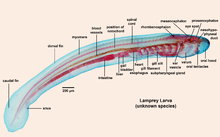
The adults spawn in nests of sand, gravel and pebbles in clear streams, and after hatching from the eggs, young larvae—called ammocoetes—will drift downstream with the current till they reach soft and fine sediment in silt beds, where they will burrow in silt, mud and detritus, taking up an existence as filter feeders, collecting detritus, algae, and microorganisms.[36] The eyes of the larvae are underdeveloped, but are capable of discriminating changes in illuminance.[37] Ammocoetes can grow from 3–4 inches (8–10 cm) to about 8 inches (20 cm).[38][39] Many species change color during a diurnal cycle, becoming dark at day and pale at night.[40] The skin also has photoreceptors, light sensitive cells, most of them concentrated in the tail, which helps them to stay buried.[41] Lampreys may spend up to eight years as ammocoetes,[42] while species such as the Arctic lamprey may only spend one to two years as larvae,[43] prior to undergoing a metamorphosis which generally lasts 3–4 months, but can vary between species.[44] While metamorphosing, they do not eat.[45]
The rate of water moving across the ammocoetes' feeding apparatus is the lowest recorded in any suspension feeding animal, and they therefore require water rich in nutrients to fulfill their nutritional needs. While the majority of (invertebrate) suspension feeders thrive in waters containing under 1 mg suspended organic solids per litre (<1 mg/l), ammocoetes demand minimum 4 mg/l, with concentrations in their habitats having been measured up to 40 mg/l.[46]
During metamorphosis the lamprey loses both the gallbladder and the biliary tract,[47] and the endostyle turns into a thyroid gland.[48]
Some species, including those that are not carnivorous and do not feed even following metamorphosis,[45] live in freshwater for their entire lifecycle, spawning and dying shortly after metamorphosing.[49] In contrast, many species are anadromous and migrate to the sea,[45] beginning to prey on other animals while still swimming downstream after their metamorphosis provides them with eyes, teeth, and a sucking mouth.[50][49] Those that are anadromous are carnivorous, feeding on fishes or marine mammals.[10][51][52]
Anadromous lampreys spend up to four years in the sea before migrating back to freshwater, where they spawn. Adults create nests (called redds) by moving rocks, and females release thousands of eggs, sometimes up to 100,000.[49] The male, intertwined with the female, fertilizes the eggs simultaneously. Being semelparous, both adults die after the eggs are fertilized.[53]
Classification
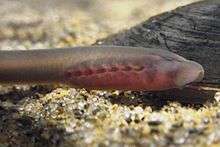
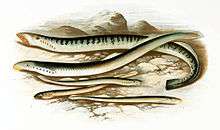
Taxonomists place lampreys and hagfish in the subphylum Vertebrata of the phylum Chordata, which also includes the invertebrate subphyla Tunicata (sea-squirts) and the fish-like Cephalochordata (lancelets or Amphioxus). Recent molecular and morphological phylogenetic studies place lampreys and hagfish in the superclass Agnatha or Agnathostomata (both meaning without jaws). The other vertebrate superclass is Gnathostomata (jawed mouths) and includes the classes Chondrichthyes (sharks), Osteichthyes (bony fishes), Amphibia, Reptilia, Aves, and Mammalia.
Some researchers have classified lampreys as the sole surviving representatives of the Linnean class Cephalaspidomorphi.[54] Cephalaspidomorpha is sometimes given as a subclass of the Cephalaspidomorphi. Fossil evidence now suggests lampreys and cephalaspids acquired their shared characters by convergent evolution.[55][56] As such, many newer works, such as the fourth edition of Fishes of the World, classify lampreys in a separate group called Hyperoartia or Petromyzontida,[54] but whether this is actually a clade is disputed. Namely, it has been proposed that the non-lamprey "Hyperoartia" are in fact closer to the jawed vertebrates.
The debate about their systematics notwithstanding, lampreys constitute a single order Petromyzontiformes. Sometimes still seen is the alternative spelling "Petromyzoniformes", based on the argument that the type genus is Petromyzon and not "Petromyzonta" or similar. Throughout most of the 20th century, both names were used indiscriminately, even by the same author in subsequent publications. In the mid-1970s, the ICZN was called upon to fix one name or the other, and after much debate had to resolve the issue by voting. Thus, in 1980, the spelling with a "t" won out, and in 1981, it became official that all higher-level taxa based on Petromyzon have to start with "Petromyzont-".
The following taxonomy is based upon the treatment by FishBase as of April 2012 with phylogeny compiled by Mikko Haaramo.[57] Within the order are 10 living genera in three families. Two of the latter are monotypic at genus level today, and in one of them a single living species is recognized (though it may be a cryptic species complex):[58]
| Petromyzontiformes |
| |||||||||||||||||||||||||||||||||||||||||||||||||||
- Geotria australis Gray 1851 (Pouched lamprey)
- Mordacia lapicida (Gray 1851) (Chilean lamprey)
- Mordacia mordax (Richardson 1846) (Australian lamprey)
- Mordacia praecox Potter 1968 (Non-parasitic/Australian brook lamprey)
- Petromyzon marinus Linnaeus 1758 (Sea lamprey)
- Ichthyomyzon bdellium (Jordan 1885) (Ohio lamprey)
- Ichthyomyzon castaneus Girard 1858 (Chestnut lamprey)
- Ichthyomyzon fossor Reighard & Cummins 1916 (Northern brook lamprey)
- Ichthyomyzon gagei Hubbs & Trautman 1937 (Southern brook lamprey)
- Ichthyomyzon greeleyi Hubbs & Trautman 1937 (Mountain brook lamprey)
- Ichthyomyzon unicuspis Hubbs & Trautman 1937 (Silver lamprey)
- Caspiomyzon wagneri (Kessler 1870) Berg 1906 (Caspian lamprey)
- Caspiomyzon graecus (Renaud & Economidis 2010) (Ionian brook lamprey)
- Caspiomyzon hellenicus (Vladykov et al. 1982) (Greek lamprey)
- Tetrapleurodon geminis Álvarez 1964 (Mexican brook lamprey)
- Tetrapleurodon spadiceus (Bean 1887) (Mexican lamprey)
- Entosphenus folletti Vladykov & Kott 1976 (Northern California brook lamprey)
- Entosphenus lethophagus (Hubbs 1971) (Pit-Klamath brook lamprey)
- Entosphenus macrostomus (Beamish 1982) (Lake lamprey)
- Entosphenus minimus (Bond & Kan 1973) (Miller Lake lamprey)
- Entosphenus similis Vladykov & Kott 1979 (Klamath river lamprey)
- Entosphenus tridentatus (Richardson 1836) (Pacific lamprey)
- Lethenteron alaskense Vladykov & Kott 1978 (Alaskan brook lamprey)
- Lethenteron appendix (DeKay 1842) (American brook lamprey)
- Lethenteron camtschaticum (Tilesius 1811) (Arctic lamprey)
- Lethenteron kessleri (Anikin 1905) (Siberian brook lamprey)
- Lethenteron ninae Naseka, Tuniyev & Renaud 2009 (Western Transcaucasian lamprey)
- Lethenteron reissneri (Dybowski 1869) (Far Eastern brook lamprey)
- Lethenteron zanandreai (Vladykov 1955) (Lombardy lamprey)
- Eudontomyzon stankokaramani (Karaman 1974) (Drin brook lamprey)
- Eudontomyzon morii (Berg 1931) (Korean lamprey)
- Eudontomyzon danfordi Regan 1911 (Carpathian brook lamprey)
- Eudontomyzon mariae (Berg 1931) (Ukrainian brook lamprey)
- Eudontomyzon vladykovi (Oliva & Zanandrea 1959) (Vladykov's lamprey)
- Lampetra aepyptera (Abbott 1860) (Least brook lamprey)
- Lampetra alavariensis Mateus et al. 2013 (Portuguese lamprey)
- Lampetra auremensis Mateus et al. 2013 (Qurem lamprey)
- Lampetra ayresi (Günther 1870) (Western river lamprey)
- Lampetra fluviatilis (Linnaeus 1758) (European river lamprey)
- Lampetra hubbsi (Vladykov & Kott 1976) (Kern brook lamprey)
- Lampetra lanceolata Kux & Steiner 1972 (Turkish brook lamprey)
- Lampetra lusitanica Mateus et al. 2013 (lusitanic lamprey)
- Lampetra pacifica Vladykov 1973 (Pacific brook lamprey)
- Lampetra planeri (Bloch 1784) (European brook lamprey)
- Lampetra richardsoni Vladykov & Follett 1965 (Western brook lamprey)
- Entosphenus macrostomus Dr. Dick Beamish 1980 (Cowichan lake lamprey)
Fossil record
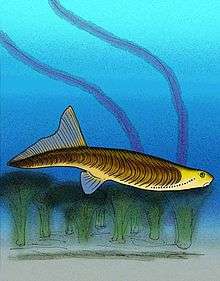

Lamprey fossils are rare because cartilage does not fossilize as readily as bone. The first fossil lampreys were originally found in Early Carboniferous limestones, marine sediments in North America: Mayomyzon pieckoensis and Hardistiella montanensis, from the Mississippian Mazon Creek lagerstätte and the Bear Gulch limestone sequence. None of the fossil lampreys found to date have been longer than 10 cm (3,9 inches),[61] and all the Paleozoic forms have been found in marine deposits.[62]
In the 22 June 2006 issue of Nature, Mee-mann Chang and colleagues reported on a fossil lamprey from the Yixian Formation of Inner Mongolia. The new species, morphologically similar to Carboniferous and other forms, was given the name Mesomyzon mengae ("Meng Qingwen's Mesozoic lamprey").
The exceedingly well-preserved fossil showed a well-developed sucking oral disk, a relatively long branchial apparatus showing a branchial basket, seven gill pouches, gill arches, and even the impressions of gill filaments, and about 80 myomeres of its musculature. Unlike the North American fossils, its habitat was almost certainly fresh water.[63]
Months later, a fossil lamprey even older than the Mazon Creek genera was reported from Witteberg Group rocks near Grahamstown, in the Eastern Cape of South Africa. Dating back 360 Million years, this species, Priscomyzon riniensis, is very similar to lampreys found today.[64][65][66]
Use in research
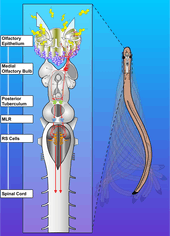
The lamprey has been extensively studied because its relatively simple brain is thought in many respects to reflect the brain structure of early vertebrate ancestors. Beginning in the 1970s, Sten Grillner and his colleagues at the Karolinska Institute in Stockholm followed on from extensive work on the lamprey started by Carl Rovainen in the 1960s that used the lamprey as a model system to work out the fundamental principles of motor control in vertebrates starting in the spinal cord and working toward the brain.[68]
In a series of studies by Rovainen and his student James Buchanan, the cells that formed the neural circuits within the spinal cord capable of generating the rhythmic motor patterns that underlie swimming were examined. Note that there are still missing details in the network scheme despite claims by Grillner that the network is characterised (Parker 2006, 2010[69][70]). Spinal cord circuits are controlled by specific locomotor areas in the brainstem and midbrain, and these areas are in turn controlled by higher brain structures, including the basal ganglia and tectum.
In a study of the lamprey tectum published in 2007,[71] they found electrical stimulation could elicit eye movements, lateral bending movements, or swimming activity, and the type, amplitude, and direction of movement varied as a function of the location within the tectum that was stimulated. These findings were interpreted as consistent with the idea that the tectum generates goal-directed locomotion in the lamprey.
Lampreys are used as a model organism in biomedical research, where their large reticulospinal axons are used to investigate synaptic transmission.[72] The axons of lamprey are particularly large and allow for microinjection of substances for experimental manipulation.
They are also capable of full functional recovery after complete spinal cord transection. Another trait is the ability to delete several genes from their somatic cell lineages, about 20% of their DNA, which are vital during development of the embryo, but which in humans can cause problems such as cancer later in life, after they have served their purpose. How the genes destined for deletion are targeted is not yet known.[73][74]
In human culture
As food
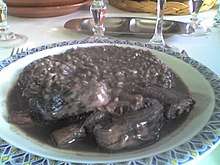
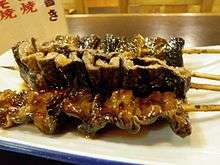
Lampreys have long been used as food for humans.[75] They were highly appreciated by the ancient Romans. During the Middle Ages, they were widely eaten by the upper classes throughout Europe—especially during Lent when eating meat was prohibited, on account of their meaty taste and texture. King Henry I of England is claimed to have been so fond of lampreys that he often ate them late into life and poor health against the advice of his physician concerning their richness, and is said to have died from eating "a surfeit of lampreys". Whether or not his lamprey indulgence actually caused his death is unclear.[76]
On 4 March 1953, Queen Elizabeth II's coronation pie was made by the Royal Air Force using lampreys.[77]
In southwestern Europe (Portugal, Spain, and France), the northern half of Finland and in Latvia (where lamprey is routinely sold in supermarkets), larger lampreys are still a highly prized delicacy. In Latvia, the river lamprey is the symbol of the Carnikava Municipality, found on its coat of arms.
Sea lamprey is the most sought-after species in Portugal and one of only two that can legally bear the commercial name "lamprey" (lampreia): the other one being Lampetra fluviatilis, the European river lamprey, both according to Portaria (Government regulation no. 587/2006, from 22 June). "Arroz de lampreia" or lamprey rice is one of the most important dishes in Portuguese cuisine.
Lampreys are also consumed in Sweden, Russia, Lithuania, Estonia, Japan, and South Korea. In Finland, they are commonly sold pickled in vinegar.[78]
The mucus and serum of several lamprey species, including the Caspian lamprey (Caspiomyzon wagneri), river lampreys (Lampetra fluviatilis and L. planeri), and sea lamprey (Petromyzon marinus), are known to be toxic, and require thorough cleaning before cooking and consumption.[79][80]
In Britain, lampreys are commonly used as bait, normally as dead bait. Northern pike, perch, and chub all can be caught on lampreys. Frozen lampreys can be bought from most bait and tackle shops.
As pests

Sea lampreys have become a major pest in the North American Great Lakes. It is generally believed that they gained access to the lakes via canals during the early 20th century,[81][82] but this theory is controversial.[83] They are considered an invasive species, have no natural enemies in the lakes, and prey on many species of commercial value, such as lake trout.[81]
Lampreys are now found mostly in the streams that feed the lakes, and controlled with special barriers to prevent the upstream movement of adults, or by the application of toxicants called lampricides, which are harmless to most other aquatic species; however, these programs are complicated and expensive, and do not eradicate the lampreys from the lakes, but merely keep them in check.[84]
New programs are being developed, including the use of chemically sterilized male lampreys in a method akin to the sterile insect technique.[85] Finally, pheromones critical to lamprey migratory behaviour have been isolated, their chemical structures determined, and their impact on lamprey behaviour studied, in the laboratory and in the wild, and active efforts are underway to chemically source and to address regulatory considerations that might allow this strategy to proceed.[86][87][88]
Control of sea lampreys in the Great Lakes is conducted by the U.S. Fish and Wildlife Service and the Canadian Department of Fisheries and Oceans, and is coordinated by the Great Lakes Fishery Commission.[89] Lake Champlain, bordered by New York, Vermont, and Quebec, and New York's Finger Lakes are also home to high populations of sea lampreys that warrant control.[90] Lake Champlain's lamprey control program is managed by the New York State Department of Environmental Conservation, the Vermont Department of Fish and Wildlife, and the U.S. Fish and Wildlife Service.[90] New York's Finger Lakes sea lamprey control program is managed solely by the New York State Department of Environmental Conservation.[90]
In folklore
In folklore, lampreys are called "nine-eyed eels". The name is derived from the seven external gill slits that, along with one nostril and one eye, line each side of a lamprey's head section. Likewise, the German word for lamprey is Neunauge, which means "nine-eye",[91] and in Japanese they are called yatsume-unagi (八つ目鰻, "eight-eyed eels"), which excludes the nostril from the count. In British folklore, the monster known as the Lambton Worm may have been based on a lamprey, since it is described as an eel-like creature with nine eyes.
In literature
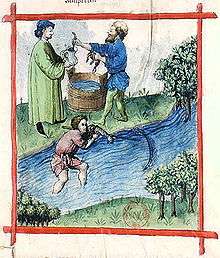
Vedius Pollio kept a pool of lampreys into which slaves who incurred his displeasure would be thrown as food.[92] On one occasion, Vedius was punished by Augustus for attempting to do so in his presence:
...one of his slaves had broken a crystal cup. Vedius ordered him to be seized and then put to death, but in an unusual way. He ordered him to be thrown to the huge lampreys which he had in his fish pond. Who would not think he did this for display? Yet it was out of cruelty. The boy slipped from the captor's hands and fled to Augustus' feet asking nothing else other than a different way to die – he did not want to be eaten. Augustus was moved by the novelty of the cruelty and ordered him to be released, all the crystal cups to be broken before his eyes, and the fish pond to be filled in...
This incident was incorporated into the plot of the 2003 novel Pompeii by Robert Harris in the incident of Ampliatus feeding a slave to his lampreys.
Lucius Licinius Crassus was mocked by Gnaeus Domitius Ahenobarbus (cos. 54 BC) for weeping over the death of his pet lamprey:
So, when Domitius said to Crassus the orator, Did not you weep for the death of the lamprey you kept in your fish pond? – Did not you, said Crassus to him again, bury three wives without ever shedding a tear? – Plutarch, On the Intelligence of Animals, 976a[94]
This story is also found in Aelian (Various Histories VII, 4) and Macrobius (Saturnalia III.15.3). It is included by Hugo von Hofmannsthal in the Chandos Letter:
And in my mind I compare myself from time to time with the orator Crassus, of whom it is reported that he grew so excessively enamoured of a tame lamprey – a dumb, apathetic, red-eyed fish in his ornamental pond – that it became the talk of the town; and when one day in the Senate Domitius reproached him for having shed tears over the death of this fish, attempting thereby to make him appear a fool, Crassus answered, "Thus have I done over the death of my fish as you have over the death of neither your first nor your second wife."
I know not how oft this Crassus with his lamprey enters my mind as a mirrored image of my Self, reflected across the abyss of centuries.
— Philip, Lord Chandos, (fictional) younger son of the Earl of Bath, in a letter to Francis Bacon[95]
In George R. R. Martin's novel series, A Song of Ice and Fire, Lord Wyman Manderly is mockingly called "Lord Lamprey" by his subjects in reference to his rumored affinity to lamprey pie and his striking obesity.[96]
Kurt Vonnegut, in his late short story "The Big Space Fuck", posits a future America so heavily polluted – "Everything had turned to shit and beer cans", in his words – that the Great Lakes have been infested with a species of massive, man-eating ambulatory lampreys.[97]
References
- Froese, Rainer, and Daniel Pauly, eds. (2009). "Petromyzontiformes" in FishBase. January 2009 version.
- Fossilworks: Order Petromyzontiforme
- "lamprey". Oxford University Press. Retrieved 12 February 2014.
- https://www.ctriver.org/sea-lamprey-the-ancient-fish/
- DOCKER, Margaret F (2006). "Bill Beamish's Contributions to Lamprey Research and Recent Advances in the Field". Guelph Ichthyology Reviews. 7. Archived from the original on 27 August 2014. Retrieved 12 June 2014.
- Hardisty, M. W.; Potter, I. C. (1971). Hardisty, M. W.; Potter, I. C. (eds.). The Biology of Lampreys (1st ed.). Academic Press. ISBN 9780123248015.
- Lafferty, Kevin D; Kuris, Armand M (1 November 2002). "Trophic strategies, animal diversity and body size". Trends in Ecology & Evolution. 17 (11): 507–513. doi:10.1016/S0169-5347(02)02615-0. ISSN 0169-5347.
- Gill, Howard S.; Renaud, Claude B.; Chapleau, François; Mayden, Richard L.; Potter, Ian C.; Douglas, M. E. (2003). "Phylogeny of Living Parasitic Lampreys (Petromyzontiformes) Based on Morphological Data". Copeia. 2003 (4): 687–703. doi:10.1643/IA02-085.1.
- Potter, Ian C.; Gill, Howard S.; Renaud, Claude B.; Haoucher, Dalal (25 November 2014), "The Taxonomy, Phylogeny, and Distribution of Lampreys" (PDF), Lampreys: Biology, Conservation and Control, Springer Netherlands, pp. 35–73, doi:10.1007/978-94-017-9306-3_2, ISBN 9789401793056, retrieved 21 October 2018
- Silva, S.; Araújo, M. J.; Bao, M.; Mucientes, G.; Cobo, F. (2014). "The haematophagous feeding stage of anadromous populations of sea lamprey Petromyzon marinus: low host selectivity and wide range of habitats". Hydrobiologia. 734 (1): 187–199. doi:10.1007/s10750-014-1879-4. hdl:10261/98126.
- "Prehistoric bloodsucker in Thames". BBC News. 1 July 2009. Retrieved 27 September 2012.
- "Giant blood sucker found in River Wear". The Northern Echo. 25 June 2009.
- Lehman, Don. "Chemical concerns may halt Lake Champlain treatments". poststar.com. The Post Star.
- Iuliis, Gerardo De; Deiuliis, Gerald; Pulera, Dino (3 August 2006). The Dissection of Vertebrates: A Laboratory Manual. ISBN 9780080477350.
- Haaramo, Mikko (11 March 2008). "Mikko's Phylogeny Archive". Retrieved 26 January 2009.
- Heimberg, A. M.; Cowper-Sal-Lari, R.; Sémon, M.; Donoghue, P. C.; Peterson, K. J. (2010). "MicroRNAs reveal the interrelationships of hagfish, lampreys, and gnathostomes and the nature of the ancestral vertebrate". Proceedings of the National Academy of Sciences of the United States of America. 107 (45): 19379–83. doi:10.1073/pnas.1010350107. PMC 2984222. PMID 20959416.
- "In swimming, jellyfish and lampreys really pull their weight". Los Angeles Times.
- Potter, Ian C.; Gill, Howard S. (2003). "Adaptive Radiation of Lampreys". Journal of Great Lakes Research. 29: 95–112. doi:10.1016/S0380-1330(03)70480-8.
- Khidir, K. Teresa (2003). "Oral fimbriae and papillae in parasitic lampreys (Petromyzontiformes)". Environmental Biology of Fishes. 66 (3): 271–278. doi:10.1023/A:1023961910547.
- Rohde, Klaus (13 September 2005). Marine Parasitology. ISBN 9780643099272.
- Ehrlich, Hermann (1 December 2014). Biological Materials of Marine Origin: Vertebrates. ISBN 9789400757301.
- Warren, Melvin L., Jr; Burr, Brooks M. (10 July 2014). Freshwater Fishes of North America: Volume 1: Petromyzontidae to Catostomidae. ISBN 9781421412016.
- Renaud, C. B.; Gill, H. S.; Potter, I. C. (2009). "Relationships between the diets and characteristics of the dentition, buccal glands and velar tentacles of the adults of the parasitic species of lamprey". Journal of Zoology. 278 (3): 231–242. doi:10.1111/j.1469-7998.2009.00571.x.
- "What we know about lampreys -- the arctic bloodsuckers that swarm Alaska rivers by the millions".
- "CANADA: A Surfeit of Lampreys". Time. 9 May 1955. Retrieved 7 June 2008.
- Liem, Karel F.; William E. Bemis; Warren F. Walker, Jr.; Lance Grande (2001). Functional Anatomy of the Vertebrates. The United States of America: Thomson: Brooks/Cole. p. 50. ISBN 978-0-03-022369-3.
- Streit, B.; Städler, T.; Lively, C.M (11 March 2013). Evolutionary Ecology of Freshwater Animals: Concepts and Case Studies. ISBN 9783034888806.
- Cochran, Philip A. (2008). "Observations on Giant American Brook Lampreys (Lampetra appendix)". Journal of Freshwater Ecology. 23: 161–164. doi:10.1080/02705060.2008.9664567.
- Poppick, Laura (2 November 2015). "Only the hot sea lamprey guys get sex -- thermally, that is". NBC News.
- Nagawa, Fumikiyo; Kishishita, Natsuko; Shimizu, Kazumichi; Hirose, Satoshi; Miyoshi, Masato; Nezu, Junnya; Nishimura, Toshinobu; Nishizumi, Hirofumi; Takahashi, Yoshimasa; et al. (2007). "Antigen-receptor genes of the agnathan lamprey are assembled by a process involving copy choice". Nature Immunology. 8 (2): 206–13. doi:10.1038/ni1419. PMID 17187071.
- Pancer, Z.; Amemiya, C. T.; Ehrhardt, G. T. R. A.; Ceitlin, J.; Gartland, G.; Cooper, M. D. (2004). "Somatic diversification of variable lymphocyte receptors in the agnathan sea lamprey" (PDF). Nature. 430 (6996): 174–180. Bibcode:2004Natur.430..174P. doi:10.1038/nature02740. hdl:2027.42/62870. PMID 15241406.
- Froese, Rainer, and Daniel Pauly, eds. (2017). "Petromyzontidae" in FishBase. February 2017 version.
- Macey, D. J.; Cake, M. H.; Potter, I. C. (1988). "Exceptional iron concentrations in larval lampreys (Geotria australis) and the activities of superoxide radical detoxifying enzymes". Biochemical Journal. 252 (1): 167–172. doi:10.1042/bj2520167. PMC 1149120. PMID 3421899.
- "Three-eyed lizards are not uncommon. Four-eyed ones are a novelty". The Economist. 5 April 2018. Retrieved 10 April 2018.
- Nieuwenhuys, R (1998). The central nervous system of vertebrates. Berlin New York: Springer. p. 454. ISBN 978-3-540-56013-5.
- Evans, Thomas M. (2012). Assessing Food and Nutritional Resources of Native and Invasive Lamprey Larvae Using Natural Abundance Isotopes (Thesis). Ohio State University.
- Orlov, Alexei; Beamish, Richard (26 April 2016). Jawless Fishes of the World: Volume 2. p. 204. ISBN 9781443892407.
- McNeill Alexander, R. (6 August 1981). The Chordates. ISBN 9780521236584.
- Ecology of the New Zealand Lamprey (Geotria australis) - A literature review (PDF). Securing Blue Duck in the Central North Island : Technical Report. September 2008. ISBN 978-0-478-14542-7. ISSN 1179-1659.
- Young, J. Z. (July 1935). "The Photoreceptors of Lampreys: II. The Functions of the Pineal Complex". Journal of Experimental Biology. 12 (3): 254–270.
- Kershaw, Diana R. (6 December 2012). Animal Diversity. p. 229. ISBN 9789401160353.
- Docker, Margaret F. (24 November 2014). Lampreys: Biology, Conservation and Control. p. 109. ISBN 9789401793063.
- Lampreys (PDF), Alaska Department of Fish and Game
- Docker, Margaret F. (24 November 2014). Lampreys: Biology, Conservation and Control. ISBN 9789401793063.
- Silva, S.; Servia, M. J.; Vieira-Lanero, R.; Cobo, F. (2013). "Downstream migration and hematophagous feeding of newly metamorphosed sea lampreys (Petromyzon marinus Linnaeus, 1758)". Hydrobiologia. 700: 277–286. doi:10.1007/s10750-012-1237-3.
- Mallatt, Jon (1984). "Feeding ecology of the earliest vertebrates". Zoological Journal of the Linnean Society. 82 (3): 261–272. doi:10.1111/j.1096-3642.1984.tb00643.x.
- Docker, Margaret F. (24 November 2014). Lampreys: Biology, Conservation and Control. ISBN 9789401793063.
- Kluge, B; Renault, N; Rohr, KB (2005). "Anatomical and molecular reinvestigation of lamprey endostyle development provides new insight into thyroid gland evolution". Dev Genes Evol. 215 (1): 32–40. doi:10.1007/s00427-004-0450-0. PMID 15592682.
- "Lampreys" (PDF). Alaska Department of Fish and Game. 2004. Retrieved 8 July 2012.
- Silva, S.; Servia, M. J.; Vieira-Lanero, R.; Nachón, D. J.; Cobo, F. (2013). "Haematophagous feeding of newly metamorphosed European sea lampreys Petromyzon marinus on strictly freshwater species". Journal of Fish Biology. 82 (5): 1739–1745. doi:10.1111/jfb.12100. PMID 23639169.
- Beamish, F. W. H. (1980). "Biology of the North American anadromous sea lamprey, Petromyzon marinus". Canadian Journal of Fisheries and Aquatic Sciences. 37 (11): 1924–1943. doi:10.1139/f80-233.
- Nichols, O. C.; Tscherter, U. T. (2011). "Feeding of sea lampreys Petromyzon marinus on minke whales Balaenoptera acutorostrata in the St Lawrence Estuary". Journal of Fish Biology. 78 (1): 338–343. doi:10.1111/j.1095-8649.2010.02842.x. PMID 21235565.
- Beamish, F W H; Medland, T E (1988). "Age Determination for Lampreys". Transactions of the American Fisheries Society. 117 (1): 63–71. doi:10.1577/1548-8659(1988)117<0063:ADFL>2.3.CO;2.
- Nelson, J. S. (2006). Fishes of the World (4th ed.). New York: John Wiley and Sons, Inc. pp. 601 pp. ISBN 978-0-471-25031-9.
- Forey, Peter; Janvier, Philippe (2000). "Agnathans and the origin of jawed vertebrates". In Gee, Henry (ed.). Shaking the tree: readings from Nature in the history of life. USA: University of Chicago Press; Nature/Macmillan Magazines. pp. 251–266. ISBN 978-0-226-28497-2.
- Janvier, P. (2008). "Early Jawless Vertebrates and Cyclostome Origins". Zoological Science. 25 (10): 1045–1056. doi:10.2108/zsj.25.1045. PMID 19267641.
- Haaramo, Mikko (2003). "Petromyzontidae – lampreys". In Mikko's Phylogeny Archive. Retrieved 25 November 2013.
- Froese, Rainer, and Daniel Pauly, eds. (2012). "Petromyzontiformes" in FishBase. April 2012 version.
- Froese, Rainer, and Daniel Pauly, eds. (2017). "Petromyzontidae" in FishBase. February 2017 version.
- "Petromyzontidae" (PDF). Deeplyfish- fishes of the world. Retrieved 18 May 2017.
- Green, SA; Bronner, ME (2014). "The lamprey: a jawless vertebrate model system for examining origin of the neural crest and other vertebrate traits". Differentiation. 87 (1–2): 44–51. doi:10.1016/j.diff.2014.02.001. PMC 3995830. PMID 24560767.
- Chang, M.; Wu, F.; Miao, D.; Zhang, J. (2014). "Discovery of fossil lamprey larva from the Lower Cretaceous reveals its three-phased life cycle". Proceedings of the National Academy of Sciences. 111 (43): 15486–15490. Bibcode:2014PNAS..11115486C. doi:10.1073/pnas.1415716111. PMC 4217442. PMID 25313060.
- Chang, M. M.; Zhang, J.; Miao, D. (2006). "A lamprey from the Cretaceous Jehol biota of China". Nature. 441 (7096): 972–974. Bibcode:2006Natur.441..972C. doi:10.1038/nature04730. PMID 16791193.
- "Discovery of the Oldest Fossil Lamprey in the World". University of the Witwatersrand. 26 October 2006. Archived from the original on 16 March 2008. Retrieved 8 June 2008.
- "Scientists find lamprey a 'living fossil'". University of Chicago Medicine. 26 October 2006.
- Gess, R. W.; Coates, M. I.; Rubidge, B. S. (2006). "A lamprey from the Devonian period of South Africa". Nature. 443 (7114): 981–984. Bibcode:2006Natur.443..981G. doi:10.1038/nature05150. PMID 17066033.
- Derjean, D; Moussaddy, A; Atallah, E; St-Pierre, M; Auclair, F; Chang, S; Dubuc, R (2010). "A novel neural substrate for the transformation of olfactory inputs into motor output". PLOS Biology. 8 (12): e1000567. doi:10.1371/journal.pbio.1000567. PMC 3006349. PMID 21203583.
- Grillner, S. (2003). "The motor infrastructure: From ion channels to neuronal networks". Nature Reviews Neuroscience. 4 (7): 573–586. doi:10.1038/nrn1137. PMID 12838332.
- Parker, D (2006). "Complexities and uncertainties of neuronal network function". Philosophical Transactions of the Royal Society B: Biological Sciences. 361 (1465): 81–99. doi:10.1098/rstb.2005.1779. PMC 1626546. PMID 16553310.
- Parker, D (2010). "Neuronal network analyses: premises, promises and uncertainties". Phil Trans R Soc Lond B. 365 (1551): 2315–2328. doi:10.1098/rstb.2010.0043. PMC 2894952. PMID 20603354.
- Saitoh, K.; Ménard, A.; Grillner, S. (2007). "Tectal Control of Locomotion, Steering, and Eye Movements in Lamprey". Journal of Neurophysiology. 97 (4): 3093–3108. doi:10.1152/jn.00639.2006. PMID 17303814.
- Brodin, L.; Shupliakov, O. (2006). "Giant reticulospinal synapse in lamprey: Molecular links between active and periactive zones". Cell and Tissue Research. 326 (2): 301–310. doi:10.1007/s00441-006-0216-2. PMID 16786368.
- Gitig, Diana (28 January 2018). "Odd vertebrate gets rid of hundreds of genes early in development".
- Smith, Jeramiah J.; Timoshevskaya, Nataliya; Ye, Chengxi; Holt, Carson; Keinath, Melissa C.; Parker, Hugo J.; Cook, Malcolm E.; Hess, Jon E.; Narum, Shawn R.; Lamanna, Francesco; Kaessmann, Henrik; Timoshevskiy, Vladimir A.; Waterbury, Courtney K. M.; Saraceno, Cody; Wiedemann, Leanne M.; Robb, Sofia M. C.; Baker, Carl; Eichler, Evan E.; Hockman, Dorit; Sauka-Spengler, Tatjana; Yandell, Mark; Krumlauf, Robb; Elgar, Greg; Amemiya, Chris T. (2018). "The sea lamprey germline genome provides insights into programmed genome rearrangement and vertebrate evolution". Nature Genetics. 50 (2): 270–277. doi:10.1038/s41588-017-0036-1. PMC 5805609. PMID 29358652.
- Araujo, Mario; Silva, Sergio; Stratoudakis, Yorgos; Gonçalves, Marta; López, Rodrigo; Carneiro, Miguel; Martins, Rogélia; Cobo, Fernando; Antunes, Carlos (1 March 2016). "Sea Lamprey Fisheries in the Iberian Peninsula". In Orlov, Alexei; Beamish, Richard (eds.). Jawless Fishes of the World: Volume 2. pp. 115–148. ISBN 978-1443887199.
- Green, Judith A. (2 March 2006). Henry I: King of England and Duke of Normandy. p. 1. ISBN 978-0521591317.
- "Gloucester lamprey pie is fit for the Queen". BBC News. 20 April 2012.
- "Lamprey". Nordic Recipe Archive. Retrieved 1 December 2017.
- Froese, Rainer and Pauly, Daniel, eds. (2012). "Lampetra fluviatilis" in FishBase. September 2012 version. (citing Bristow, Pamela (30 April 1992). The Illustrated Encyclopedia of Fishes. London: Chancellor Press. ISBN 9781851521364.).
- Deshpande, S. S. (29 August 2002). Handbook of Food Toxicology. CRC Press. p. 695. ISBN 978-0824707606.
- Gunn, J.M.; Steedman, R.J.; Ryder, R.A., eds. (2003). Boreal Shield Watersheds Lake Trout Ecosystems in a. London: CRC Press. p. 40. ISBN 9780203495087. Retrieved 8 November 2015.
- Alexander, Jeff (2009). Pandora's locks the opening of the Great Lakes-St. Lawrence Seaway. East Lansing, Mich.: Michigan State University Press. ISBN 9781609171971. Retrieved 8 November 2015.
- Williams, Ted (2007). Something's Fishy an Angler's Look at Our Distressed Gamefish and Their Waters – And How We Can Preserve Both. New York: Skyhorse Publishing, Inc. p. 382. ISBN 9781628731972. Retrieved 8 November 2015.
- O'Sullivan, P.E.; Reynolds, C.S., eds. (2007). The Lakes Handbook, Volume 2. Oxford: John Wiley & Sons. p. 81. ISBN 9781405141109. Retrieved 8 November 2015.
- Siefkes, Michael J; Bergstedt, Roger A; Twohey, Michael B; Li, Weiming (2003). "Chemosterilization of male sea lampreys (Petromyzon marinus) does not affect sex pheromone release". Canadian Journal of Fisheries and Aquatic Sciences. 60 (1): 23–31. doi:10.1139/f02-169. ISSN 0706-652X.
- Peter W. Sorensen, 2015, "Applications of pheromones in invasive fish control and fishery conservation (Ch. 12)," in Fish Pheromones and Related Cues (P.W. Sorensen & B.D. Wisenden, Eds.), pp. 255–268, ISBN 978-0813823867, Hoboken, NJ, USA:Wiley-Blackwell, see and , accessed 1 July 2015.
- Sorensen, P. W.; Hoye, T. R. (2007). "A critical review of the discovery and application of a migratory pheromone in an invasive fish, the sea lamprey Petromyzon marinus L". Journal of Fish Biology. 71: 100–114. doi:10.1111/j.1095-8649.2007.01681.x.
- Mary L. Moser, Pedro R. Almeida, Paul S. Kemp & P.W. Sorensen, 2014, "Lamprey spawning migration (Ch. 5, §5.6.1, Pheromones)," in Lampreys: Biology, Conservation and Control, Vol. 1 (Margaret F. Docker, Ed., Vol. 37, Fish & Fisheries Series), Berlin, BE, DEU:Springer, ISBN 9401793069, see , accessed 1 July 2015.
- "Sea Lamprey Control in the Great Lakes A remarkable success!" (PDF). Great Lakes Fishery Commission. Archived from the original (PDF) on 27 April 2015.
- "Sea Lamprey Lake Champlain Sea Lamprey Control". New York State Department of Environmental Conservation. July 2009.
- Entry in Grimm's German Dictionary, online edition at Trier University
- Dio 52.23.2; Pliny the Elder, Natural History 9.39; Seneca the Younger, On Clemency 1.18.2.
- Seneca the Younger. L. ANNAEI SENECAE AD NOVATVM DE IRA LIBER III [On Anger] (in Latin). III. Thelatinlibrary.com.
- Plutarch. The Morals. V. Ralph Waldo Emerson. Little, Brown and company. Translated by William Watson Goodwin.
- von Hofmannsthal, Hugo (1902). "The Letter of Lord Chandos".
- Martin, George R. R. (16 November 1998). A Clash of Kings (1st ed.). Voyager Books. ISBN 978-0-00-224585-2.
- "Kurt Vonnegut: "The Big Space Fuck"". www.pierretristam.com. Retrieved 22 March 2017.
Further reading
General
- Renaud, C.B. (2011) Lampreys of the world. An annotated and illustrated catalogue of lamprey species known to date FAO Species Catalogue for Fishery Purposes. No. 5. Rome. ISBN 978-92-5-106928-8.
Research on pheromones for pest control
- Sorensen, Peter W.; Fine, Jared M.; Dvornikovs, Vadims; Jeffrey, Christopher S.; Shao, Feng; Wang, Jizhou; Vrieze, Lance A.; Anderson, Kari R.; Hoye, Thomas R. (2005). "Mixture of new sulfated steroids functions as a migratory pheromone in the sea lamprey". Nature Chemical Biology. 1 (6): 324–328. doi:10.1038/nchembio739. PMID 16408070., see , accessed 1 July 2015. [Primary source example.]
- Dittman, Andrew (2005). "News and Views: Chemical cues for sea lamprey migration". Nature Chemical Biology (Submitted manuscript). 1 (6): 316–317. doi:10.1038/nchembio1105-316. PMID 16408065., see , accessed 1 July 2015. [Lay summary of Sorensen, et al. (2005)]
- Johnson, Nicholas S.; Yun, Sang-Seon; Thompson, Henry T.; Brant, Cory O.; Li, Weiming (2009). "A synthesized pheromone induces upstream movement in female sea lamprey and summons them into traps". Proceedings of the National Academy of Sciences. 106 (4): 1021–1026. doi:10.1073/pnas.0808530106. PMC 2633527. PMID 19164592. [Primary source example.]
- Richard Black, 2009, "Sex smell lures 'vampire' to doom," BBC News (online), 20 January 2009, see , accessed 1 July 2015. [Lay summary of Johnson, et al. (2009); Subtitle: "A synthetic 'chemical sex smell' could help rid North America's Great Lakes of a devastating pest, scientists say."]
External links
| Wikispecies has information related to Petromyzontiformes |
| The Wikibook Dichotomous Key has a page on the topic of: Petromyzonidae |

- "ITIS report on the lampreys". ITIS. Retrieved 27 September 2012.
- "Lamprey". Inland Fisheries Ireland. Retrieved 27 September 2012.
- "The Tree of Life". Retrieved 27 September 2012. A Tree of Life diagram showing the relation of Lampreys to other organisms.
